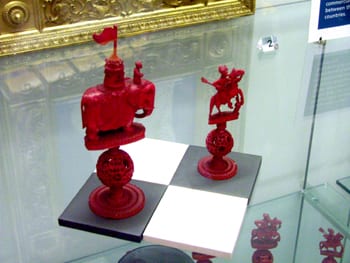Only once in my life have I ever encountered an object in a museum display case which delivered such an emotional sucker-punch as to physically stop me breathing.
One of the fun things about objects in museum collections is the way in which you can appreciate them in the context of your own life, experiences, sometimes even your own body. For example, when looking at the gynaecology specimens in UCL’s pathology collections they are full of resonance for me because I’ve got similar (hopefully considerably less diseased) bits sitting inside me and because my mother was, for over four decades, a gynaecologist and obstetrician. [1] In the Galton Collection, I have classified my hair and eye colour according using the colour scales and devices which were used at the Galton Laboratory.[2]

The ivory chessmen on display at Nottingham Museum and Art Gallery. Image courtesy Ynys Crowston-Boaler.
I’ve also experienced those little moments of recognition for things which, even when you see them for the first time, are somehow immediately familiar and speak directly to you. The ones I remember best are the hugely spectacular – like the ceiling of the Sistine Chapel or the statue of Christ the Redeemer in Rio – and those that refer to memorable thoughts and experiences. On a visit to Nottingham, I was blown away by these ivory chessmen which sit in a case at Nottingham Museum and Art Gallery and are exactly like the ones described in my favourite novel. I stood gawping at those chessmen for much longer than any other exhibit in the museum, even the fancy modern artworks which were what I had actually gone to see. Running a close second on the same trip was the statue of Robin Hood at the bottom of the hill leading up to the castle, which featured in a documentary about Torvill and Dean, a recording of which I had watched repeatedly and obsessively as a five-year-old.[3]
Given that I am aware of the evocative power of objects, the emotional (and physical!) winding I mentioned at the start of this blog may have been a shock, but it wasn’t entirely a surprise. The object in question was this, in one of the more innocuous displays at the Design Museum in Copenhagen. Up until that point I had been happily strolling through the galleries taking pictures of chairs – of which they have an extensive typology, going ‘Oooh…!’ at the Japanese porcelain vessels and trying to work out why there was a bottle of Heineken in a case that otherwise only exclusively held antique silverware.
Then, suddenly, blithely sitting in a case, was this; my Dad’s CD player.
(more…)
 Close
Close




